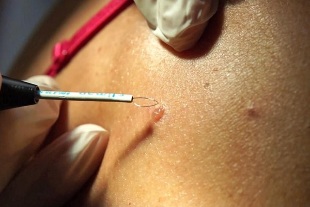
People usually do not suspect that there is human papillomavirus (HPV) in the human body. This is because the papillomavirus usually exists in a latent form and is suppressed by natural immunity. When it loses control and begins to actively manifest itself in the form of growth in different parts of the body, problems arise. Compared with women, men are less likely to be affected by the virus, but for them, its effects may become a serious problem in the form of papilloma on the penis.
Cause of occurrence
Viral DNA enters the human body through microcracks in the skin or mucous membranes. If a person's immunity weakens, the initial manifestations of HPV will appear several months after infection.
As many as 80% of transmission is through sexual means. Barrier contraception minimizes the risk of infection, but it cannot completely eliminate it.
Other infection methods:
- Home path.The virus will spread with the personal belongings of the infected person: clothes, hygiene products, etc. If the skin is damaged, even the smallest skin, the risk of transmission will increase. This pathway is characterized by infection with a low-carcinogenic type of virus. They do not cause serious health problems, but can appear in the form of genital warts, papillomas, and warts, which can cause appearance defects.
- From mother to child.If the mother is infected with HPV during pregnancy and childbirth and gives birth naturally, the baby is likely to be infected.
If a person has a good immune defense ability, the virus will not show itself and can stay in the body for a long time in a latent form. Therefore, the danger is not the infection of the virus itself, but the weakening of the immune system, which leads to the activation of HPV.
There are many factors that affect the possibility of strengthening the location of the virus:
- Chronic diseases;
- Hormonal problems;
- The wrong choice of contraception or no contraception at all;
- Virus infection;
- Alcoholism, smoking or long-term use of antibiotics;
- Constant pressure.
All these factors have a negative impact on the immune system. If in a person's life, there is not a motivating factor, but a motivating factor, then this will cause the papillomavirus to develop more rapidly.
Symptoms
Usually, papilloma appears only externally, but in some cases,may show non-specific symptoms:
- Itching and burning during intercourse;
- Pain when touching the papilloma;
- Urine accumulates in the folds of the penis;
- There is an unpleasant smell in the affected area.
In addition, tumors can not only grow and affect the penis area, but also appear on the anus and pubic bone.

Papilloma-like
Papilloma of the penis is a small tumor. At first, she may appear alone, but without proper treatment, the number of papillomas will increase. However, they can be combined with each other.
These growths look like flesh-colored or pink cauliflower inflorescences. In most cases, they are located in the foreskin, head and frenulum. Less commonly, they are diagnosed as urethra and scrotum. Papilloma can also appear as long rows of white small papules. This form is a typical form of localization in the bridle area.
One of the manifestations of HPV is Buschke-Levenshtein warts. It is known for its rapid growth, outstanding size and resistance to various treatments. Its appearance is attributed to several existing papillomas and warts, which merge together to form a large lesion area. The existence of genital warts Buschke-Levenshtein is dangerous because the cells altered by it can easily develop into cancer.
Which doctor to contact
Usually, urologists handle the diagnosis of male papilloma. If you have genital warts in the anal area, you can also seek advice from a dermatologist or proctologist. However, papilloma is usually referred to a surgeon. In general, the diagnosis process is divided into the following stages:
- The urologist examines and interviews the patient.Oral questioning is necessary to assess the patient’s lifestyle and determine the cause of the virus infection. Visual inspection involves not only evaluating the condition of the penis, but also the neighboring organs-the scrotum and anal area. This is a necessary condition to complete virus positioning.
- Urethral smear.Determine the existence of various sexually transmitted diseases.
- PCR.This analysis not only shows the presence of HPV in the body, but also probably determines its type.
- Visual inspection.This process is to check whether the papillomavirus has infected the frenulum urethra.
- After the papilloma is removed, the doctor may request a biopsyto evaluate the condition of the removed tumor. This is necessary to eliminate the risk of cancer and ensure that the papilloma is benign.
In this case, it is best to conduct a survey of both partners. Usually, women are also infected with a papillomavirus. If only one person is treated, he is likely to get sick again after some time.
Why papilloma is dangerous
Human papillomavirus is often accompanied by other related diseases. The appearance of papillomas in the glans penis area contributes to the accumulation of urine in the folds. This created conditions for the emergence and growth of various microorganisms, which subsequently led to infections. They can cause erosions around papillomas and can also cause inflammation of the urethra and testicles. These diseases are characterized by problems with urination, pain and high fever.
Another danger is trauma to the tumor, which can cause bleeding. This is due to the fact that many blood vessels are formed around the papilloma, providing them with blood. Even minor damage can cause infection due to injury.
In addition, the tumor will rub when it moves, which can cause pain and discomfort to men.
HPV and cancer
When the virus just started to spread, the tumors were sporadic and benign. If not treated, they will merge and grow with each other. Over time, the cells will degenerate into malignant cells.If a person is infected with the highly carcinogenic type 16 or 18 virus, the risk of cancer is particularly high.
Treatment of papilloma
The treatment of HPV involves not only eliminating its external manifestations, but also strengthening the immune system, which should block the manifestations of the virus.Immunostimulants are used to maintain immunity.
As an antiviral drug, an ointment that inhibits virus reproduction and eliminates small growth is effective. It is not always able to cope with the task of complete removal, but it can prevent the emergence of new growth. Prescribe antiviral ointment to stimulate immunity. The ointment will not remove the papilloma, but it will promote the activation of immune system cells, thereby preventing their growth and development.

How to delete
There are several ways to get rid of the new growth:
- Laser removal.The laser beam acts on the papilloma, thereby completely burning the papilloma. A layer of skin formed in this place and disappeared after a few weeks. Since there is no recurrence, this method is considered effective. Resection is performed under anesthesia. No bleeding, no scars or scars.
- Destroy frozen.The papilloma is exposed to liquid nitrogen. It immediately freezes the desired area, and the tumor on it collapses and dies. The disadvantage of this method is that the depth of freezing damage cannot be controlled. A layer of crusty remained at the site of the removed papilloma, which disappeared after a while.
- Radiosurgery.The principle of this method is similar to laser removal. Radio waves will not leave scars and scars, and special anesthesia is performed before the operation. After that, there are no complications, and the body will recover soon.
- Electrocoagulation.Electric current affects growth, so the legs are eliminated, and then the papilloma disappears. Superficial anesthesia can be performed if necessary. The process takes a few minutes and is extensive and affordable. But this method can leave scars after healing.
- Surgery.In rare cases, if the tumor is too large, it can be used. It is completed under anesthesia and has long-term healing and trauma effects. The advantage of this method is that the removed growth can be preserved for histological examination.
The cost of each method depends on the complexity of the work, the size and number of papillomas to be removed.
Please consult your doctor before choosing a method. He will tell you what is best to use in your situation and tell you in detail how the process is performed. Similarly, after tumor removal, it is recommended to obtain histological materials. This is necessary in order to determine whether the process of degenerating benign tumors into malignant tumors has begun. This method will help detect early cell changes and prevent the spread of cancer.














































































